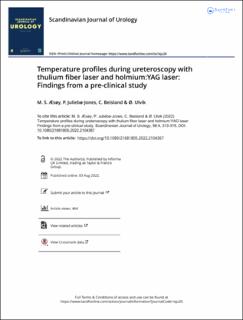| dc.contributor.author | Æsøy, Mathias S. | |
| dc.contributor.author | Jones, Charles Patrick Warburton | |
| dc.contributor.author | Beisland, Christian | |
| dc.contributor.author | Ulvik, Øyvind | |
| dc.date.accessioned | 2022-10-28T11:58:13Z | |
| dc.date.available | 2022-10-28T11:58:13Z | |
| dc.date.created | 2022-10-24T13:27:33Z | |
| dc.date.issued | 2022 | |
| dc.identifier.issn | 2168-1805 | |
| dc.identifier.uri | https://hdl.handle.net/11250/3028870 | |
| dc.description.abstract | Objective
The aim of this study was to investigate temperature profiles in both the renal pelvis and parenchyma during Thulium Fiber Laser (TFL) and Holmium:yttrium-aluminium-garnet (Ho:YAG) laser activation in an ex-vivo porcine model.
Methods
Three porcine kidneys with intact renal pelvis and proximal ureters were used in the study. A temperature sensor was inserted through a nephrostomy tube into the renal pelvis and a second sensor was inserted directly into the renal parenchyma. Temperatures were recorded during continuous laser activation for 180 s, and for an additional 60 s after deactivation. TFL (150 μm and 200 μm) and Ho:YAG (270 μm) laser delivered power at settings of 2.4 W, 8 W, 20 W and 30 W.
Results
Intrapelvic temperatures correlated directly to power settings. Higher power produced higher temperatures. For example, using a 150 μm fiber at 2.4 W resulted in a 2.6 °C rise from baseline (p = 0.008), whereas using the same fiber at 20 W produced a rise in temperature of 19.9 °C (p = 0.02). Larger laser fibers caused significantly higher temperatures compared to smaller fibers using equivalent power settings, e.g. mean temperature at 20 W using 150 μm was 39.6 °C compared to 44.9 °C using 200 μm, p < 0.001. There was a significant increase in parenchymal temperatures when applying 20 W and 30 W of laser power with the two larger fibers.
Conclusion
In this ex-vivo study, renal temperatures correlated directly to power settings. Higher power produced higher temperatures. Furthermore, larger laser fibers caused higher temperatures. These findings could help guide selection of safe power settings for ureteroscopic lithotripsy, but future clinical studies are needed for confirmation. | en_US |
| dc.language.iso | eng | en_US |
| dc.publisher | Taylor & Francis | en_US |
| dc.rights | Attribution-NonCommercial-NoDerivatives 4.0 Internasjonal | * |
| dc.rights.uri | http://creativecommons.org/licenses/by-nc-nd/4.0/deed.no | * |
| dc.title | Temperature profiles during ureteroscopy with thulium fiber laser and holmium:YAG laser: Findings from a pre-clinical study | en_US |
| dc.type | Journal article | en_US |
| dc.type | Peer reviewed | en_US |
| dc.description.version | publishedVersion | en_US |
| dc.rights.holder | Copyright 2022 The Author(s) | en_US |
| cristin.ispublished | true | |
| cristin.fulltext | original | |
| cristin.qualitycode | 1 | |
| dc.identifier.doi | 10.1080/21681805.2022.2104367 | |
| dc.identifier.cristin | 2064423 | |
| dc.source.journal | Scandinavian Journal of Urology | en_US |
| dc.source.pagenumber | 313-319 | en_US |
| dc.identifier.citation | Scandinavian Journal of Urology. 2022, 56 (4), 313-319. | en_US |
| dc.source.volume | 56 | en_US |
| dc.source.issue | 4 | en_US |

